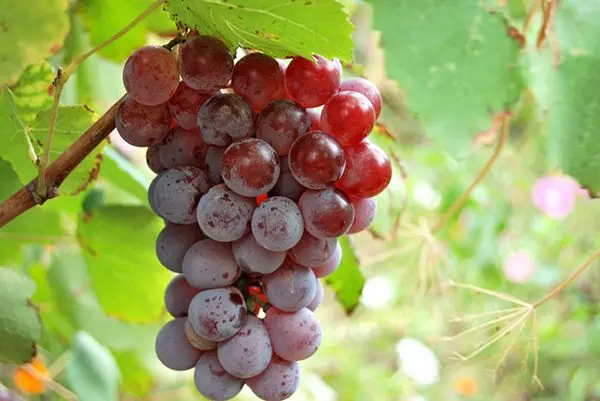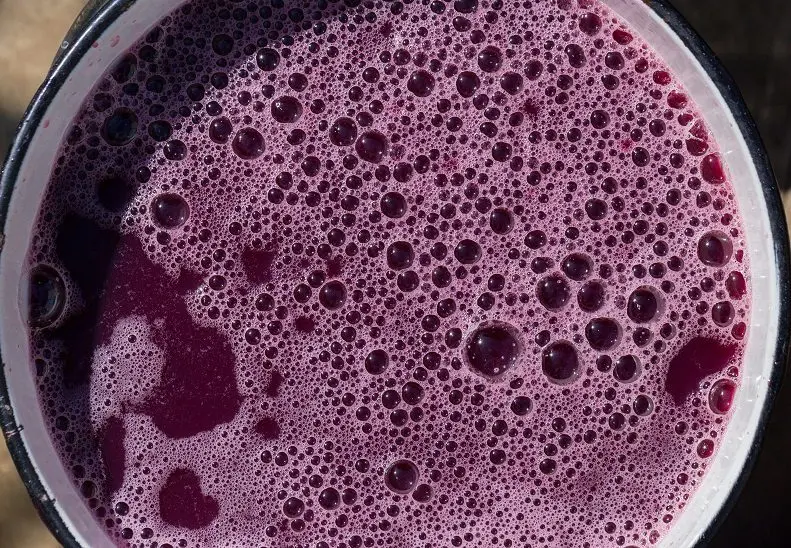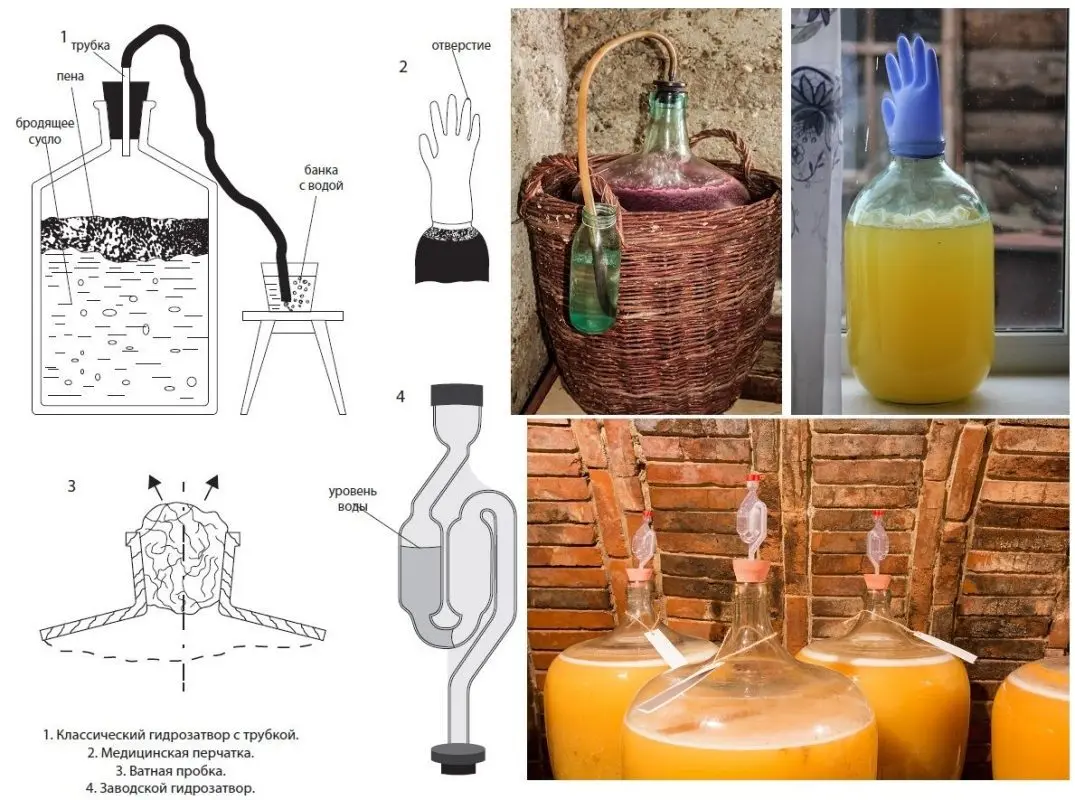Contents
Round, pinkish with a purple tint berries of the Lydia variety are easily recognized not only by experienced growers, but also by summer residents. This variety is common in the southern regions of Russia, Ukraine and Moldova. Differs in unpretentiousness in leaving, stable productivity and resistance to the majority of diseases. Often, vines are planted not for the sake of berries, but more for decorative purposes – to shade courtyards and open areas. However, if the harvest is good, I advise you to make wine from Lydia according to a simple recipe. We will consider the complete technology of preparation with the ability to adjust the sweetness and strength of the drink.
Theory
“Lydia” refers to the so-called “Isabella” grape varieties, which, in addition to “Isabella” itself, also includes Tiras, Raindor, Seibel, Kuderk and other hybrids bred by crossing cultivated European grapes with wild American. These technical varieties (mainly used for making wines) are easily recognizable by their characteristic strawberry flavor and peculiar aroma, which in the West is called “fox smell”. The presence of a specific aroma in the finished wine is due to the high concentration of essential oils in the berries.
Attention! The European Union and the United States have banned the export of wines based on hybrid varieties, including Lydia. The problem is the high content of pectins, which turn into dangerous methyl alcohol during fermentation, so drinking wine from Lydia in large quantities is harmful. Interestingly, fresh berries are safe in this regard.
Depending on the region of growth and the number of sunny days per year, the sugar content of Lydia grapes reaches 15-19%, which is a fairly high figure. Acidity fluctuates in the range of 5,5-9,3 grams / liter and does not require adjustment. In fact, dry wine with a strength of 9-11% can be made from ripe berries without adding beet sugar.

Ingredients:
- ягоды «Лидии» — 10 кг;
- sugar – 30-300 grams per 1 liter of juice;
- water – up to 100 ml per 1 liter of juice (preferably not added);
- wine yeast – according to the instructions on the label (optional).
The proportions of sugar depend on the desired sweetness of the wine. During the fermentation period, the total sugar content of the must should not exceed 20-24% (adjusted to the desired values with beet sugar), resulting in a dry wine with a strength of 11-14% (often a maximum of 12%), which after fermentation is sweetened to taste.
Water is very rarely needed to reduce acidity if the season was rainy and the berries are very sour. In all other cases, the addition of water reduces the concentration of solids, which negatively affects the taste of the wine and the duration of storage.
Магазинные винные дрожжи гарантировано запустят брожение и зачастую дают максимальную крепость – 14%, но можно обойтись дикими штаммами, которые находятся на кожице ягод. Добавлять хлебопекарные прессованные или сухие дрожжи нельзя, иначе вместо вина получится брага.
To prevent contamination of the wort with pathogenic microorganisms, before cooking, all tools and containers must be sterilized with boiling water, then wiped dry. Work with raw materials only with clean, well-washed hands.
Wine recipe from Lydia
1. It is advisable to harvest in warm, dry weather (no rain for 2-3 days), so that wild wine yeast remains on the surface of the berries, which activates fermentation. For the same reason, it is better not to wash the grapes or if you use store-bought wine yeast.
2. Sort the grapes, remove twigs, leaves, spoiled, unripe, rotten and moldy fruits. One bad berry can ruin an entire batch of wine.
3. Mash the berries with your hands (preferably) or with a wooden rolling pin, trying not to crush the bones, otherwise you will get a drink with a slight bitterness.
4. Fold the resulting mass into a plastic or enameled (not aluminum) container with a wide neck – a bucket, pan or barrel. Add store bought yeast, if desired, and stir. Cover with cheesecloth or thick cloth to keep out flies and other insects.
5. Перенести емкость в темное помещение с температурой 18-27°C, оставить на 1-2 дня.

Спустя 6-20 часов должны появиться признаки брожения: пена, характерный запах и шипение. Каждые 8-12 часов перемешивать сусло рукой или деревянной палкой, утапливая в соке мезгу – всплывшие на поверхность мякоть и кожицу, иначе возможно скисание и появление плесени.
In most cases, the fermentation of red wine on the pulp lasts 3-4 days, but in the case of Lydia, it is better to halve this period so that there are fewer pectins in the must, which are responsible for the appearance of methyl alcohol.
6. Strain the wort through 2-3 layers of gauze, squeeze the pulp to dryness (no longer needed). Taste pure juice. If it is very sour, stings the tongue and reduces the cheekbones, reduce the acidity with water.
7. If possible, determine the concentration of sugar in the wort with a saccharometer (vinomer). If this device is not available, you will have to navigate by average proportions. The total sugar content (in juice and added sugar) during the fermentation period should not exceed 24%. After measuring the initial values, calculate the required amount of sugar and divide by 3.
If there is no measuring device, we will assume that the juice contains 15% sugar (150 grams per liter), then to obtain the desired sweetness of the must, another 90 grams / l of beet sugar is required, which we will add in three stages in equal parts to maintain active fermentation.
8. Добавить третью часть сахара (в нашем примере 30 грамм на 1 литр) в сусло, перемешать до полного растворения.
9. Pour the juice into the fermentation tank, filling up to a maximum of 75% of the volume. Install a water seal of any design (you can use a medical glove with a pierced hole in one of the fingers). Transfer the container to a dark room (cover with a thick cloth) with a stable temperature of 20-28°C.

10. After 5 days from the installation of the water seal, add a second portion of sugar (30 g/l in the example). To do this, open the container, drain separately 0,5 liters of wort for each kilogram introduced, dilute the sugar in the juice, pour the resulting syrup back into the fermentation container and close it with a water seal.
11. Еще через 7-8 дней внести оставшийся сахар (третью порцию) по технологии, описанной на предыдущем этапе.
12. Depending on the temperature and yeast activity, the fermentation of Lidia wine lasts 35-50 days. Then the gas stops coming out of the water seal (the glove deflates), a layer of loose sediment is visible at the bottom, and the wort becomes noticeably lighter and almost all the foam disappears from the surface. Carefully, trying not to touch the sediment, pour the young wine into another container through a straw.
Attention! If fermentation does not stop for 50 days from the date of filtering the pulp, so that bitterness does not appear, the wine must be removed from the sediment and again put under a water seal to ferment at the same temperature.
13. Taste the drink, optionally sweeten with sugar to taste. It can also be fixed with vodka or ethyl alcohol (2-10% of the volume of wine). Fixing contributes to better storage, but somewhat spoils the aroma and taste.
14. Перелить вино в емкости для выдержки, стараясь наполнять по горлышко, чтобы не было контакта с воздухом. Герметично закрыть. Если делалось подслащение на предыдущем этапе, первые 7-10 дней держать под водяным затвором на случай повторного брожения.
15. Move homemade wine from Lydia to a dark, cool place – a refrigerator or a cellar with a temperature of 5-16°C. Leave for at least 3-4 months (preferably 6-8) for ripening, which significantly improves the taste – sharpness disappears.
16. When a precipitate appears with a layer of 2-4 cm, filter the drink by pouring it through a straw (at first every 10-15 days, then less often).
17. Wine from grapes “Lydia” is considered ready if the sediment no longer falls. The drink can be bottled for storage and hermetically sealed with stoppers.
Shelf life when stored in a cellar or refrigerator is up to 5 years. Fortress – 10-14%.










